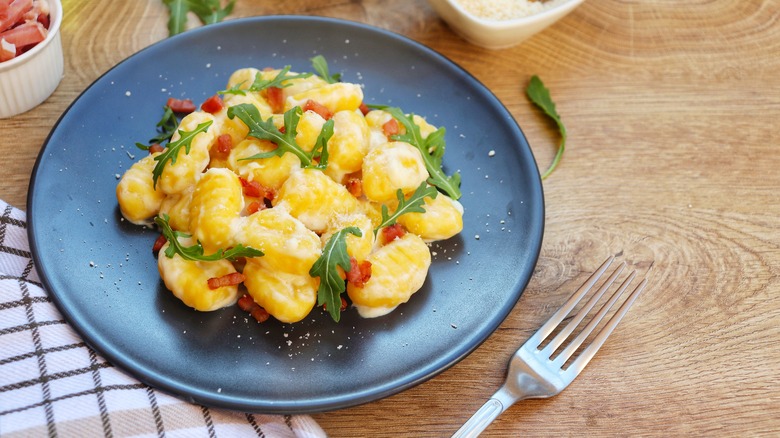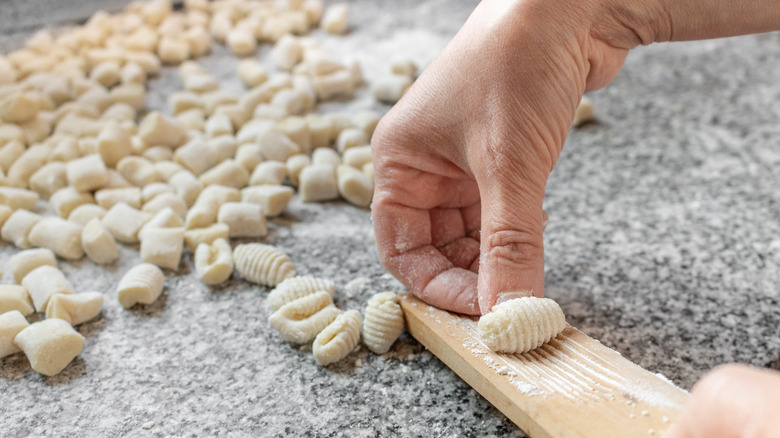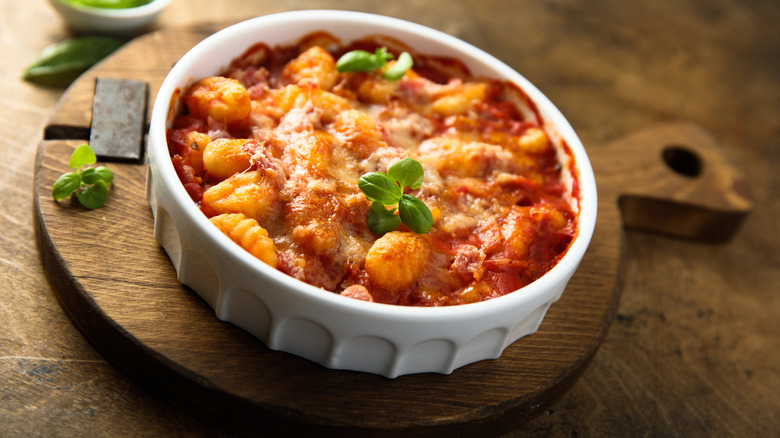Is Gnocchi A Pasta Or Dumpling?
We may receive a commission on purchases made from links.
For many, gnocchi is a must-try dish. The pillowy, tender-but-slightly-chewy soft little chunks of dough are delicious and versatile. They can be served with red pasta sauce, added to meat or chicken recipes, or simply coated in butter and herbs. They are sublime no matter how they are served. But there's an inherent question that arises whenever the Italian dish comes to the fore: Are they dumplings, or are they pasta?
Then again, it might be best to figure out what the definitions for pasta and dumplings are, respectively. Pasta is made from water and finely milled flour via BBC Good Food. Eggs are sometimes added for color and richness. The dough is cut into various shapes, dried (or not, at least when it comes to fresh pasta), then cooked in simmering water until tender but still with a bit of texture, called al dente, which means "to the tooth" in Italian, according to MasterClass.
Dumplings, on the other hand, differ in many ways from pasta, according to NPR's The Salt. The earliest forms appeared in China more than a thousand years ago, and then later in Europe during the Renaissance. Dumplings are typically made from mashed potatoes and flour, or just flour and water. They can be solid lumps of dough or filled with luscious ingredients including meat, cheese, fruit, or potatoes, for a double carb hit. And now, once again to the age-old question attached to this Italian specialty: Is gnocchi a type of pasta or a type of dumpling?
Pasta or dumpling?
The earliest versions of what we know as gnocchi were made with what was available in Italy around the 15th century, according to Saveur. Among the first iterations of what we now know as gnocchi included dried bread crumbs, almonds, and milk, though starting in the 16th century, flour was added into the mix. Saveur states that in the 1800s, Pellegrino Artusi, "the grandfather of Italian cuisine," introduced potato gnocchi, which is the common gnocchi we now know and love today.
The type of gnocchi you find in Italy varies by region. Jenn Louis, a food writer and chef, tells The Splendid Table that regionality is very important in Italy, and the same goes for Italian cuisine. Gnocchi made of breadcrumbs is more common in the northern part of the country — but in central Italy, gnocchi made of potatoes or ricotta is more common. And in the south, semolina, which is a type of flour made from corn, is the main ingredient in their gnocchi.
So is gnocchi considered a kind of pasta, or is it actually a category of dumpling? According to Saveur, these little pillows are the "predecessors of pasta" — so a major influence on pasta, but not necessarily a type of pasta itself. A number of authoritative sources consider them dumplings rather than pasta, including the aforementioned Louis, Chef Greg Baker of Food & Wine, and Italian cookbook author Giuliano Hazan, who asserts that "the word gnocchi can mean any kind of dumpling."
Gobble up some gnocchi
However you classify them, gnocchi is delicious and deserves a regular place on your table. There are many recipes available to make gnocchi from scratch — but if you don't feel like doing that, you can buy them fresh in the refrigerated section of your supermarket as well as in the frozen aisle. Follow the package directions to cook them if you choose the quick and easy route.
If you want to make your own, try a classic potato-based homemade gnocchi made with russet potatoes, egg, and cream. You can even make them using mashed potato flakes as is included in this recipe for potato gnocchi, or make some sweet potato gnocchi with brown butter and sage. Want to go old school? Serve with a glass of wine and a table set with a checked red tablecloth, with flickering candles in old wine bottles — and you can regale your dining companies with your knowledge of gnocchi.


